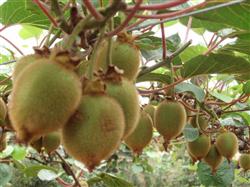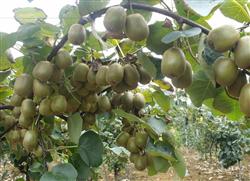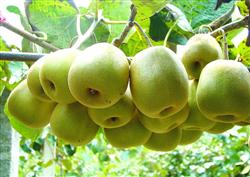Kiwifruit planting technology: how to manage kiwifruit in June?

How to manage kiwifruit in June? Please introduce the method June is the kiwifruit expansion period, but also the second peak period of fertilizer demand and the most serious period of diseases and insect pests, it is very important to grasp this month management. one。 Continue pruning in the four seasons: the fruit trees pruned in May sparsely removed dense and overlapping branches, disease and insect branches and weak branches. Fruit branch coring: there are two fruiting branches side by side, one of which leaves only one leaf on the first fruit; when the other fruiting branch is cultured as next year's fruiting mother branch, 3-4 leaves are left on the first fruit, and the ratio of leaf to fruit is 6-8:1. For the developing branches, it is a good result for next year that the mother branches have been coring and continue to be cultured, leaving 10-12 leaves to pick the cords. Long branches leave 3-4 leaves to pick the heart, sparse from the base without space. Do not let it grow, or it will grow branches of the useless. two。 Grasping the control of diseases and insect pests is the key: pay attention to the control of spotted wax cicada, oriental small salary beetle, bug bug, red spider, aphid and brown spot, branch blight, gray mold and so on. You can choose 2.5% chlorpyrifos 2000 times or Alito 2000-3000 times + 25% Jinlux 6000 times-7500 times + Ruoshuitong 4000 times or Awei chlorpyrifos 3000-4000 times + Nanxin 1500 times + Ruoshuitong 4000 times. At the same time, add foliar fertilizer Guoyou amino acid 600 times or fulvic acid anti-drought dragon 500-600 times and appropriate rooting agent to prevent root rot. three。 Topdressing: the fruit is in the expansion period and needs a large amount of fertilizer, so it is necessary to apply fertilizer in time. Soil fertilization, foliar spraying and branch fertilization are selected to meet the maximum nutrient requirements of fruiting trees in this period. Topdressing: 1 tree topdressing Longfeida 1.5-2 kg + Wotanjia 1-1.5 kg, and 1 tree topdressing Longfei Sanyuan 1-1.5 kg + Wotanjia 0.5-1 kg. Spread or open the ditch to apply, first mix the fertilizer and soil and then cover the topsoil. Water thoroughly after application. Foliar spraying fertilizer is 600 times of amino acid or 600 times of Shuofeng "481", once every 10 days, 2-3 times continuously. For the etiolated tree, the soil can be applied 6000 times as much as Gastekopp, and the foliar spray can be applied once to reduce the cost. When the yellowing is serious, spraying the top green doubling liquid twice on the leaf surface has obvious effect. We can also choose fulvic acid drought resistance dragon 400,500times or fruit friends amino acid 200times + Skopp 5000 times irrigation root, which has obvious effect. four。 High-grafted young trees on the shelf: the new shoots of the high-grafted varieties have been put on the shelf at this time, leaving two nutrient branches separated from a lead wire in the middle of the shelf in a "Y" shape, luring to elongate in both directions, leaving a branch every 20-25 cm after sending out new shoots, elongating in two opposite directions and culturing into fruiting mother branches in the coming year. New buds are sent out under the shelf, the new shoots are all thinned out, and a single main vine is used to put them on the shelf. Low grafting sends out new shoots without a plastic rope to lure them onto the shelf, leaving only a single main vine and erasing the rest. five。 Seedling management: seedlings planted in the same year, mainly to survive, not lack of water and remove weeds, small weeds can be retained, play a cooling shade, large weeds should be removed, do not affect the growth of seedlings. six。 Orchard shading and recommendation: use cornstalk, wheat straw, cut weeds to shade, lower soil temperature and preserve soil moisture. seven。 Irrigation and drainage: conventional kiwifruit soil water content dropped to 50-60% should be irrigated, general mu irrigation water 60 cubic meters, not large water infiltration irrigation, small water irrigation. Low-lying land, rainy drainage, not stagnant water, water for a long time after the root rot. In particular, when newly planted trees are planted that year, the summer harvest is a hurdle, irrigation before the summer harvest to preserve soil moisture, shade to protect live seedlings. Most of them ignored management and protection when they entered the summer harvest, and a large number of seedlings died. In particular, young trees planted in wheat fields should pay more attention to food and management in order to keep the young trees, otherwise they will have to wait a year for replanting because of negligence and loss of life and money. Click to get more kiwifruit planting techniques click to get more fruit planting techniques
- Prev

Kiwifruit planting techniques: how to plant kiwifruit with high yield?
How to plant kiwifruit with high yield? Please introduce planting methods to grow kiwifruit if you want to obtain high yield, you can refer to the following planting methods: 1. The varieties should be selected with large fruit shape, good quality, strong disease resistance and good yield, such as Hayward, Allison, Bruno and so on. 2. Choose and build kiwifruit in the garden.
- Next

Kiwifruit planting technology: how to prevent kiwifruit sunburn?
How to prevent kiwifruit sunburn? Please guide the method kiwifruit sunburn can be prevented with reference to the following methods: first, summer pruning leaves 2-3 more leaves in the top fruit, which can block direct sunlight, especially Hayward and Jinxiang need to leave a few more leaves; second, conditional morning and evening spray water every few days, can also be matched.
Related
- Moge, come on! The staff of the peasant association in the producing area of cantaloupe were frightened when the crowd gathered.
- Causes and Solutions of low Fruit setting rate of Apple
- Symptoms and control measures of passion fruit virus disease
- Fruit growing lesson: how do apple orchards keep high yields?
- Can you build orchards in the mountains? What are the pros and cons?
- How to manage the coloring period of Crisson grape?
- This paper introduces the processing technology of two kinds of fig products.
- How much is a month for retired teachers in rural areas by 2020?
- How can strawberry planting increase sugar content? We should pay attention to management in many aspects.
- What are the cultivation techniques on how to improve the yield of golden fruit?

